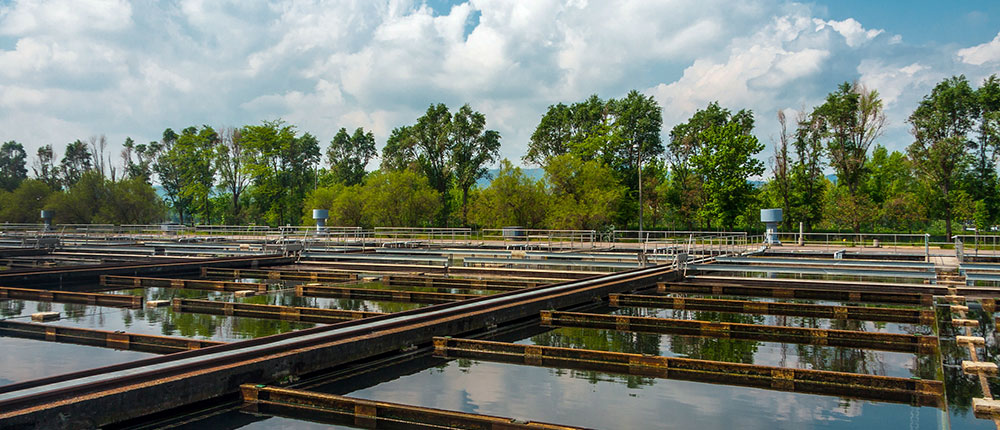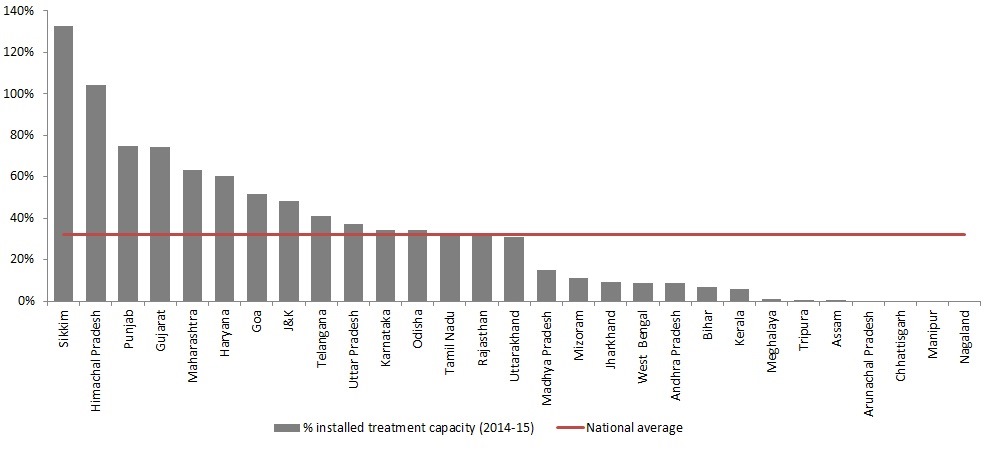As Nagpur tops the list, here is an overview of state level policies wastewater treatment and reuse

In 2017, researchers from India and the Netherlands came together to develop new methods and approaches to treat and reuse wastewater under the Local Treatment of Urban Sewage streams for Healthy Reuse (LOTUSHR) project. As a part of this five year initiative, jointly funded by the Indian and Dutch governments, TERI will contribute both to technology development as well as increase understanding of the social, political, and economic challenges that prevent water reuse in India, thus proposing strategies to address these challenges.
Drawing from our work in the LOTUSHR project, this blog provides an overview of state level policies on wastewater treatment and reuse.
According to news reports, Nagpur became the first city in India to treat and reuse approximately 90% of its sewage earlier this year. While several other cities have treatment systems in place to treat their sewage, reuse remains negligible across the country. In Nagpur, the treated wastewater will be sold to the National Thermal Power Corporation and Maharashtra State Power Generation Company to partially cover the costs of treatment. As freshwater resources become scarce, more companies, institutions, and individuals are turning to treated wastewater to meet their requirements, making the reuse of treated wastewater an increasingly economically viable option to address water scarcity.
Wastewater (including sewage)[i] can be treated and reused for several purposes, including recharging ground and surface water sources, irrigation, construction, and even domestic purposes such as flushing toilets, gardening, and cleaning vehicles among others. This can reduce pressure on freshwater resources and prevent the pollution of water bodies.
Across the country, several states have formulated policies for treatment and reuse of wastewater, including Chhattisgarh, Gujarat, Jammu and Kashmir, Jharkhand, Karnataka, Madhya Pradesh, Punjab, Rajasthan, and Telangana. This blog compares the key provisions of the policies of four states in particular in order to analyze the differing ways in which states envision ramping up the capacity for treatment and reuse of wastewater.
The extent of wastewater treatment and reuse in India
According to the NITI Aayog, approximately 33% of urban wastewater is treated in the country, and a very small part of this is reused. Central Pollution Control Board (CPCB) studied the infrastructural capacity to treat sewage in urban areas across states in 2014-15 and found that there are significant differences among states, outlined in the graph below.

Source: Lok Sabha Question No. 4066, answered on 10th August, 2018
As can be seen in the graph, in 2014-15, Sikkim and Himachal Pradesh had excess capacity, that is, they had the infrastructure to treat more sewage than was generated. Other states such as Punjab, Gujarat, Maharashtra, Haryana and Goa had the infrastructure to treat 50% or more of their sewage. However, in all other states the capacity to treat sewage was less than 50%; and less than 10% in states such as Nagaland, Manipur, Chhattisgarh, Arunachal Pradesh, Assam, Tripura, Meghalaya, Kerala, Bihar, Andhra Pradesh, West Bengal, and Jharkhand.
Data on wastewater treatment and reuse in other sectors, such as industry and agriculture is not available at the national level.
State policies
Several states have formulated policies to enable an improvement in their infrastructural capacity to treat wastewater and encourage the reuse of this water. Given differing socio-economic and geographic contexts, states have adopted varying approaches towards institutional arrangements, preferable treatment and reuse options, operation and maintenance of treatment plants, as well as pricing of the treated wastewater.
The following table provides a comparative overview of the policies of the states of Gujarat, Jharkhand, Karnataka, and Punjab.
| Gujarat | Jharkhand | Karnataka | Punjab | |
| Name, year | Policy for Reuse of Treated Waste Water, 2018 | Jharkhand Waste Water Policy, 2017 | Policy for Urban Waste Water Reuse, 2017 | State Treated Waste Water Policy, 2017 |
| Institutional arrangements | State High Power Committee (SHPC) to oversee implementation. State Technical Committee responsible for project approval, and monitoring. Treated Waste Water (TWW) Cell to prepare DPRs, build capacity and raise public awareness. ULBs responsible for implementation. | All ULBs to prepare city wastewater recycling plans for a 20 year period. State Urban Development Agency to develop a wastewater strategy and plan guidelines to outline implementation plans for ULBs. | Management Committee to oversee implementation, establish a wastewater reuse resource centre in the urban development department, and coordinate with agencies on water reuse. Urban Water Work Stream Working Group to provide advice to the government on water reuse. | Irrigation department and soil conservation department to prepare reuse plans for TWW for irrigation. Other stakeholders identified are the industry department, Punjab Agriculture University, and Punjab Energy Development Agency. |
| Treatment systems | Context specific. Options should be effective, simple to operate, low cost, and confirm to standards required for reuse. Innovative technologies to be used for tertiary treatment if required. | Context specific. Several options are listed (including primary treatment, secondary treatment, constructed wetlands, among others). | Context specific. Decentralized options will be encouraged for example through on-site treatment or en-route off take, constructed wetlands. | Context specific. Off-site treatment is encouraged, except for high rise buildings where decentralized STPs are mandated. Design and performance standards per CPHEEO manual. |
| Reuse options | Thermal power plants; industrial units; construction activities; large commercial / industrial users; maintenance of parks, lake rejuvenation, fire-fighting; agriculture. | Irrigation (agriculture, forestry, landscaping); fish-farming; industry; non-potable domestic use. | Agriculture; industry; urban non-potable use (residential, commercial, institutional); environment (discharge to water bodies, etc.); energy and nutrient recovery. | Priority to agricultural reuse, sludge may be used for power generation / fertilizers; industrial use (including thermal power plants); non-potable domestic use. |
| Operations and maintenance | Agency to be appointed by the SHPC to be responsible for the planning, execution, O&M of TWW projects. | O&M plans should be included at the design stage and should be reviewed periodically. | ULBs to explore private sector participation for O&M with balance risk allocation and performance based remuneration. | Management of infrastructure and services to be transferred from the public to the private sector through contracts. |
| Pricing | Price of TWW to be lower than freshwater. Pricing based on recovery of capital and O&M costs of distribution network, STP, and tertiary treatment. Price fixed for 1st year with escalation thereafter. Escrow account to be maintained with amounts received for TWW projects. | Full cost recovery is desirable, through appropriate user charges and pricing of TWW. Initially, it is expected that at least O&M costs should be met. | The generator pays principle to be used to include wastewater treatment costs as a part of water charges. Revenue from TWW should also be used to meet operational costs. Tariffs should be comparable to freshwater tariffs, and cross-subsidies can be applied if required. | Full cost recovery is desirable, through appropriate user charges and pricing of TWW. Initially, it is expected that at least O&M costs should be met. |
Sources: Jharkhand Waste Water Policy, 2017, Gujarat Policy for Reuse of Treated Waste Water, 2018, (Karnataka) Policy for Urban Waste Water Reuse, 2017, (Punjab) State Treated Waste Water Policy, 2017
Note: 1. For more details on these issues as well as others that are not covered in the table, please refer to the state policies. 2. SHPC – State High Power Committee; ULB – urban local body; TWW – treated waste water; DPR – Detailed Project Report; O&M – operations and maintenance; STP – sewage treatment plant; CPHEEO – Central Public Health and Environmental Engineering Organisation
Thus, states have conceptualized the institutions and processes surrounding the reuse of treated wastewater in varied ways. For example, decentralized on-site treatment options are encouraged in Karnataka while in Punjab the emphasis is on off-site treatment options along with pipelines to collect and transport wastewater. While Gujarat seeks to price treated wastewater lower than freshwater, Karnataka requires that treated wastewater tariffs be comparable to freshwater rates.
Some of these differences stem from differing priorities of states based on current water availability and use. Given the centrality of agricultural activity in the state, Punjab specifically mentions that the first preference for reuse of treated wastewater should be for irrigation while most other states do not specify irrigation as the first option for reuse.
Finally, in addition to context specific differences, some states have provided time bound targets pertaining to wastewater treatment and reuse in their policies. For example, Karnataka has set a target of developing water reuse plans in 10 major cities by 2020, and in all cities by 2030. Further, it targets reuse of 20% of treated sewage by 2020, and 50% reuse by 2030. Gujarat has set a target of reusing 75% of treated wastewater by 2025, and 100% by 2030.
This brief analysis shows that given state-specific contexts and priorities, several alternative mechanisms can be used to address water scarcity through the reuse of treated wastewater. Whether it is the set of technologies to be used for treatment, the options available to facilitate reuse of treated wastewater, or the pricing of treated wastewater, states have much to learn from each other as they build their vision and broad strategies for water management, and water recycling in particular.
Footnotes
[i] Wastewater refers to water that has been used for any purpose, while sewage refers to water that has been used for domestic purposes and then discharged into the sewage network of a city. Further, 'black water' is water that has come into contact with fecal matter (for example, water from toilets), while 'gray water' is all other types of wastewater.
References
1. Government of Gujarat (2018) Policy for Reuse of Treated Waste Water
2. Government of Jharkhand (2017) Jharkhand Waste Water Policy, 2017
3. Government of Karnataka (2017) Policy for Urban Waste Water Reuse: Enabling Environment for Urban Wastewater Reuse
4. Government of Punjab (2017) The State Treated Waste Water Policy - 2017
5. Central Pollution Control Board (2015) Inventorization of Sewage Treatment Plants
6. NITI Aayog (2018) Composite Water Managment Index: A Tool for Water Management
7. Lok Sabha Question No. 4066, answered on 10th August, 2018
